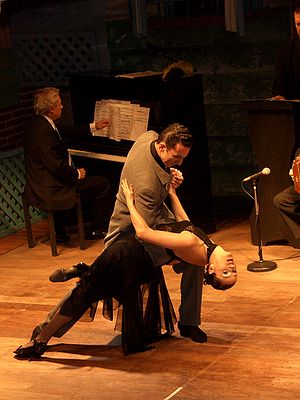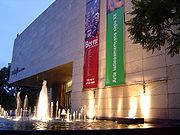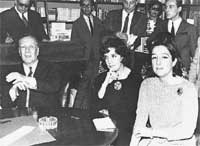Culture of Argentina
| Argentina by topic |
|---|
|
Communications |
The culture of Argentina is as varied as the country's geography and mix of ethnic groups. Modern Argentine culture has been largely influenced by European immigration although there are also some Amerindian and African influences, particularly in the fields of music and art. Buenos Aires and other cities show a mixture of architectural styles imported from Europe but in the case of older settlements, and of older preserved neighborhoods within cities, modern styles appear mixed with colonial features, relics from the Spanish-ruled past. Museums, cinemas and galleries are abundant in all the large urban centers, as well as traditional establishments such as literary bars, or bars offering live music of a variety of genres.

Contents |
Cinema and theatre

- See also: Cinema of Argentina
Argentine cinema has achieved international recognition with films such as The Official Story and 9 Queens, though it has only rarely been taken into account by mainstream popular viewers who prefer Hollywood-type movies. Even low-budget productions, however, have obtained prizes in cinema festivals (such as Cannes). The city of Mar del Plata organizes its own festival dedicated to this art.
Music
The best-known element of Argentine culture is the tango dance. In modern Argentina, tango music is enjoyed in its own right, especially since the radical Ástor Piazzolla redefined the music of Carlos Gardel. It should be noted that foreigners usually think of tango as the dance music, whilst for Argentines the word refers to both the music and the lyrics (often containing words and phrases in lunfardo, a local slang), which are a form of poetry.
Folk music and dance are popular in provincial Argentina and are blends of various native and European styles. Examples include the chamamé of Mesopotamia and the chacarera of Santiago del Estero.
Since the 1970s Rock music has been widely appreciated in Argentina. First during the 1970s and then again in the mid 1980s and the beginning of the 1990s, national rock music and pop music experienced bursts of popularity, with many new bands (such as Soda Stereo and Sumo) and composers (like Charly García and Fito Páez) becoming important exponents of national culture. National Rock and Pop then gave way to other genres, like Ska, Techno, Eurodance, Electronica and Argentine Cumbia. The wide variety of music to be heard in Argentina today is impossible to summarize in a short article; the opening up of the Argentine economy to international trade and the ready access to music downloaded from the Internet (most often illegally, through peer-to-peer networks) provide listeners with a diversity of choices. Rock music is currently the most popular form of music among younger Argentines.
A number of Argentine rock and jazz musicians have become well-known film score composers. Big band leader Lalo Schiffrin became internationally known after composing the Mission:Impossible theme in 1966. Emilio Kauderer has been composing for Argentine cinema since the 1970s and has created the film scores for Friends & Lovers and the Dead Like Me series, among others. The most successful Argentine film score writer is probably Gustavo Santaolalla who, well-established in the local rock scene since 1970, has earned two Academy Awards for his compositions since 2004.
European classical music is also popular in Argentina. The Teatro Colón in Buenos Aires is considered to be one of the world's major opera houses. Musicians such as pianist Martha Argerich and classical composers like Alberto Ginastera have become internationally renown. Most of the nation's larger cities and a number of smaller ones maintain concert halls, philharmonic orchestras and chamber music ensembles; among the best-known of these is Camerata Bariloche, founded in 1967 by Alberto Lysy.
Painting and Sculpture









Argentine painters and sculptors have a rich history dating from both before and since the development of modern Argentina in the second half of the 19th century.
Though what today is Argentina was mostly frozen over during the last ice age and, thus, is less archaeologically rich than many of its neighbors, pre-historic pictographs can be found in caves throughout the Argentine territory, though Argentina's aboriginal art heritage is quite modest compared to Peru's, for instance.
Shortly after independence in 1816, landscape painters from Europe began exploring the spacious Argentine countryside, much as many did in the United States. In the 1830s, Carlos Morel became the first influential Argentine painter and Prilidiano Pueyrredon's naïve, slice-of-life portraits made him among the few successful Argentine artists of those early days. Artistic production in Argentina, however, did not truly come into its own until after the 1852 overthrow of the repressive regime of Juan Manuel de Rosas. Immigrants like Eduardo Schiaffino, Eduardo Sívori, Reynaldo Giudici and Ernesto de la Cárcova left behind a realist heritage influential to this day.
Impressionism did not make itself evident among Argentine artists until after 1900, however, and never acquired the kind of following it did in Europe, though it did inspire influential Argentine impressionists like Martin Malharro, Ramon Silva and Fernando Fader. Realism and estheticism continued to set the agenda in Argentine painting and sculpture, noteworthy during this era for the sudden fame of sculptor Lola Mora, a student of Auguste Rodin's.
As Lola Mora had been until she fell out of favor with local high society, monumental sculptors became in very high demand after 1900, particularly by municipal governments and wealthy families, who competed with each other in boasting the most evocative mausolea for their dearly departed. Though most preferred French and Italian sculptors, locals Erminio Blotta's and Rogelio Yrurtia's prolific soulful monuments and memorials made them immortal. Not as realist as the work of some of his belle-epoque predecessors in sculpture or Blotta's, Yrurtia's subtle impressionism inspired Argentine students like Antonio Pujía, whose internationally prized female torsos always surprise admirers with their whimsical and surreal touches.
Becoming an intellectual, as well as artistic circle, painters like Antonio Berni, Lino Enea Spilimbergo and Juan Carlos Castagnino were friends as well as colleagues, going on to collaborate on masterpieces like the ceiling at the Galerias Pacifico arcade in Buenos Aires, towards 1933.
As in Mexico and elsewhere, muralism became increasingly popular among Argentine artists. Among the first to use his drab surroundings as a canvas was Benito Quinquela Martín, whose vaguely cubist pastel-colored walls painted in his Buenos Aires neighborhood of La Boca during the 1920s and 1930s have become historical monuments and Argentine cultural emblems, worldwide. Lithographs, likewise, found a following in Argentina some time after they had been made popular elsewhere. In Argentina, artists like Adolfo Bellocq used this medium to portray often harsh working conditions in Argentina's growing industrial sector, during the 1920s and 1930s. Bellocq's lithographs have become influential worldwide, since then.
The vanguard in culturally conservative Argentina, futurists and cubists like Xul Solar and Emilio Pettoruti earned a following as considerable as that of less abstract and more sentimental portrait and landscape painters, like Raul Soldi. Likewise, traditional abstract artists like Luis Barragán, Romulo Macció, Eduardo Mac Entyre, Luís Noé and Luis Seoane coexisted with equal appeal as the most conceptual mobile art creators like the unpredictable Pérez Celis, Gyula Kosice of the Argentine Madí Movement, Marta Minujín, one of Andy Warhol's most esteemed fellow conceptual artists and Leon Ferrari, one of the world's foremost constructivist artists, today. In the 1960s and 1970s, many of these painters' abstract art found their way into popular advertising and even corporate logos.
Generally possessing of a strong sentimental streak, the Argentine public's taste for naïve art and simple pottery cannot be overlooked. Since Prilidiano Pueyrredon's day, artists in the naïve vein like Cándido Lopez have captured the absurdity of war, Susana Aguirre and Aniko Szabó the idiosyncrasies of everyday neighborhoods and Gato Frías, childhood memories.
To help showcase Argentine and Latin American art and sculpture, local developer and art collector Eduardo Constantini set aside a significant portion of his personal collection and, in 1998, began construction on Buenos Aires' first major institution specializing in works by Latin American artists. His foundation opened the Buenos Aires Museum of Latin American Art (MALBA) in 2001.
Sports

Many Argentines are involved in sports. Fútbol (soccer) is more of a national obsession than a game. Argentina won the World Cup in 1978 and 1986 and the gold medal at the 2004 Summer Olympics for men's soccer, and the exploits of Diego Maradona have kept fans, paparazzi and columnists busy for the past 20 years. Recently, Lionel Messi has drawn comparisons to Maradona, and indeed Maradona himself named Messi his "successor".[1] Tennis, rugby union and field hockey are also important and Argentina won a gold medal at the 2004 Summer Olympics in Athens for men's basketball. The legendary Formula One driver, Juan Manuel Fangio, was Argentine. The rich, heavily influenced by English customs, have traditionally enjoyed polo and Argentina dominates this sport on the world scene. In recent times, the international polo player Adolfo Cambiasso has tried to broaden the appeal of polo by introducing several football traditions to polo, like celebrating goals and the like. Cambiasso's strategy has had some success when different football fans went to see the final of the Argentine Open, but has been criticized by the traditional supporters of Polo.
The official national sport of Argentina, though rarely played, is the polo-like pato. Pato literally translates to duck.
More than half of the population practices some sport or at least performs some physical exercise, such as walking or jogging. Regular practice of football, going to the gym and cycling are the three most common activities of this kind.
Language

Argentina's official language is Spanish (here usually named castellano). There are many variations of Spanish in Argentina and every province has its own accent.
Rio de la Plata Spanish is the variation used in all cities near the Rio de la Plata river, the most well-known characteristic being the use of "vos" instead of "tu" ("Voseo"). Some immigrant communities retain their own language as a badge of identity and languages such as Italian, German, English and French are spoken. The Welsh community of Patagonia have held an Eisteddfod, as well as the Basques, Arabs and Ukrainians. Recent immigrants from China and South Korea, who have established themselves in large cities like Buenos Aires and Rosario, also speak their own language among themselves, and some communities publish small-circulation newspapers in them.
Most Argentines can understand simple spoken Italian and Portuguese, due to their similarity to Spanish.
There are about 23 native languages spoken in different parts of the country, including Quechua, Mapuche, Guaraní, Toba and Wichí.
Food

Argentine cuisine is typically European. Due to the heavy influence of Italian, Spanish, French and other European cuisines the typical Argentine diet is a variation the Mediterranean diet. Argentina is known for its asado or grilled beef where meat, including entrails, is placed on a grill and barbecued over charcoal fire. There are restaurants that serve only asado and many local restaurants always have asado on the menu.
Argentines consume large amounts of beef. While the recent economic crisis has made meat expensive for many, its price is still relatively low given its outstanding quality. Meat exports are usually regulated and the European Community has set up a quota of frozen meat imports that cannot be exceeded.

Traditional foods of the provinces such as locro hark back to the pre-Columbian period, with a reliance on maize, beans and squashes (in many places, locro is traditionally consumed only on national patriotic holidays). Another traditional food is the empanada, a circular piece of pastry folded in two around a filling (including chopped meat, olives, hard-boiled egg, potato cubes, ham and cheese, and many other variants), which can be baked or fried.
Italian staple dishes like pizza and pasta are common and many Argentines choose a simple pizza with tomato, cheese and ham, although many combinations are available. Pasta is extremely common, either simple unadorned pasta with butter or oil, or accompanied by tomato or bechamel-based sauce.
Sweets, especially dulce de leche, are popular. Dulce de leche (a dark brown fluid paste, made from milk and sugar stirred at high temperature) is an essential ingredient of cakes, and shares the place of jelly and jam at breakfast. It is used to top desserts and to fill alfajores and facturas (an alfajor consists of two round biscuits, often flavored, optionally coated with chocolate, joined by a layer of jelly; factura is the generic name for sweet baked pastry of different kinds, including but not limited to croissants and donuts.
Argentina is famous for its beer, most notably the red wine from the province of Mendoza, where weather conditions (dry, warm summers) are optimal.
Literature
In terms of literature, Argentina's most famous authors are Jorge Luis Borges, considered to be one of the world's greatest 20th century writers, (he wrote poems, short stories and non-fiction essays and some people say that he was the best short story writer ever), Adolfo Bioy Casares and Julio Cortázar. Bioy Casares wrote some books in collaboration with Borges. Cortázar was voluntarily exiled in Europe during the rule of Juan Domingo Perón; Borges had problems with Peronism too, and celebrated its fall in 1955 with joy, though he later became disillusioned with the military dictators. Both Borges and Cortázar died abroad: Borges in Geneva in 1986, and Cortázar in Paris in 1984.
Argentine comics are best represented by Mafalda, a cartoon by Quino (Joaquín Lavado), which became a world-recognized Argentine icon soon after its first publication. The series of comic strips shows the world's troubles through the eyes of a small girl, Mafalda, and her relatives and friends.
Spare time
A cultural survey found that the most important spare time activity for almost 80% of Argentines is visiting friends and relatives. Playing team sports and attending sports venues is also quite common. For younger people clubbing is prevalent, while older ones prefer dining out.
An example of sociability can be found during the annual celebration of Friend's Day on 20 July. This informal holiday originated in Argentina and in recent years has gained such popularity, especially among the young, that the entertainment centers of the cities (bars, discos, cinemas, etc.) become crowded until dawn of the following day, as on Christmas and New Year's Eve.

See also
- Cuisine of Argentina
- Music of Argentina
- Football in Argentina
- Rugby union in Argentina
- The Latin American Docta
- Architecture of Argentina
- Argentine humour
- Cinema of Argentina
- Argentine Culture Rich and Diverse
References

- ↑ Reuters (2006-02-25). "Maradona proclaims Messi as his successor", China Daily. Retrieved on 2006-10-08.
- Sistema Nacional de Consumos Culturales ("National System of Cultural Consumption") - Official website. It contains a report of a comprehensive, nationwide statistical study of cultural mores, undertaken in August 2005.
|
|||||||